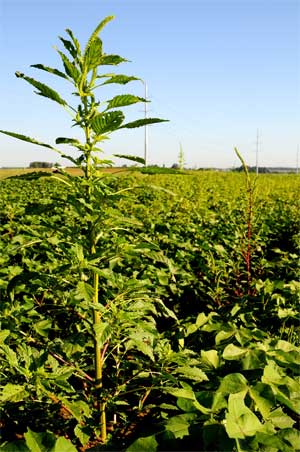Keiser, Arkansas, USA
August 10, 2009
| |
 |
|
Scientists at the University of Arkansas System’s
Division of Agriculture are conducting research on the
growing problem of glyphosate-resistant weeds in
Arkansas. In this test plot, weed scientist Jason
Norsworthy is tracking the rate at which a
one-square-meter patch of glyphosate-resistant Palmer
amaranth, or pigweed, spreads through a cotton field. |
| |
Farmers, agricultural consultants
and county agents who turned out for a field day at the
University of Arkansas System
Division of Agriculture’s Northeast Research and Extension
Center all had at least one question in common: what to do about
herbicide resistant pigweed?
Ken Smith, extension weed scientist at the Division of
Agriculture’s Southeast Research and Extension Center in
Monticello, said that eight years ago, morning glory was the
problem weed on every grower’s mind. Today, “herbicide-resistant
pigweed has choked out the morning glory,” he said.
Smith discusses the problem and management of herbicide
resistant pigweed in a Division of Agriculture Web video:
http://aaes.uark.edu/nerec_video.html
The growing problem is glyphosate resistant Palmer amaranth,
known best to farmers as Roundup resistant pigweed. First
confirmed in Mississippi County in 2005, Smith said, the
problematic weed has spread to most of the counties in eastern
Arkansas.
Research technician Ryan Doherty said glyphosate resistant
pigweed has been confirmed in 21 counties throughout the state.
A research location has been established to study control
programs in a field situation. Research on those plots is
revealing the nature of the resistance and helping to develop
management strategies.
Doherty said the most resistant pigweed population identified by
division scientists was found in Lincoln County.
“The farmer had already put two 22-ounce applications of Roundup
on that field before he called us,” Doherty said. “We put on
another 44-ounce application of Roundup and it didn’t hurt it at
all.”
Even another application of 128 ounces of Roundup did not kill
the pigweed biotype found in that field. Doherty said all those
plants probably came from a single female plant.
Smith said division scientists confirmed this month that there
are two distinct patterns of distribution in Arkansas from
pigweed plants with two different mechanisms of tolerance. In
one pattern, called segregated, the herbicide resistant plants
are scattered throughout the field randomly among plants that
are not resistant. Spraying these fields with glyphosate kills
about 80 percent of the pigweed. The remaining plants are
scattered randomly throughout the field. Smith cautioned that
resistance is creeping up in these pigweed populations; 80
percent may be killed this year, but next year it may be only 70
percent.
Smith calls the second pattern non-segregated. In these fields,
the resistant plants are clustered tightly together and
glyphosate herbicide does not kill any of them. “All the
offspring of these plants have high levels of resistance,” he
said.
“When you see these,” Smith advised, “Do whatever you have to do
to take them out.”
Smith said Division of Agriculture scientists had devised a
number of strategies to control glyphosate resistant pigweed,
most involving a combination of different herbicides beginning
with a preplant application. Roundup is still a valuable weed
control product, he said, because it controls more than 100
other weeds. But it will have to be part of a new program for
weed control.
“There is no prescription that works in every cotton or soybean
field,” Smith said. “But in any program, soil residual
herbicides are going to be essential for controlling these
pests.”
Smith said farmers should overlap soil residual applications to
keep them on the field all the time. He recommended scouting for
pigweed at the same time growers would be scouting for insects.
Catching and killing pigweed before it matures and goes to seed
is important in controlling the spread of the weed.
Agricultural economist Bob Stark said glyphosate resistant
Palmer amaranth is the main economic concern among all herbicide
resistant weeds.
Stark said there are a lot of different chemical choices, but
Division of Agriculture economists were putting together an
economic analysis of four management strategies. The key point,
he said, was to begin planning now for next season, to consider
what herbicides are available and to consult county extension
agents about what plans will work best.
“I know we don’t have the 2009 crop in yet,” Stark said, “but
this is not too early to begin looking at 2010.”
An overnight thunderstorm forced the field day program indoors
because the fields and roads on the Northeast Research and
Extension Center were too muddy to drive or walk on. Other
topics covered:
Division entomologists Tina
Teague and Glenn Studebaker discussed management of insect
pests, particularly tarnished plant bugs. They gave an
update on insecticide efficacy based on division research
programs.
In a series of presentations by division agricultural
economists, Archie Flanders described comparative costs and
returns for field crops, Bob Stark discussed the economic
impact of herbicide resistant weeds and Scott Stiles gave an
update and talked about the inherent risks for commodity
prices.
Extension crop specialists Jason Kelley, Tom Barber, Jeremy
Ross and Chuck Wilson discussed crop conditions and
challenges for corn, sorghum, wheat, cotton, soybeans and
rice.
Erika Chudy, district director for Arkansas Congressman
Marion Berry gave a legislative update and said the
congressman will be in Arkansas in coming weeks during a
Congressional recess.
|
|